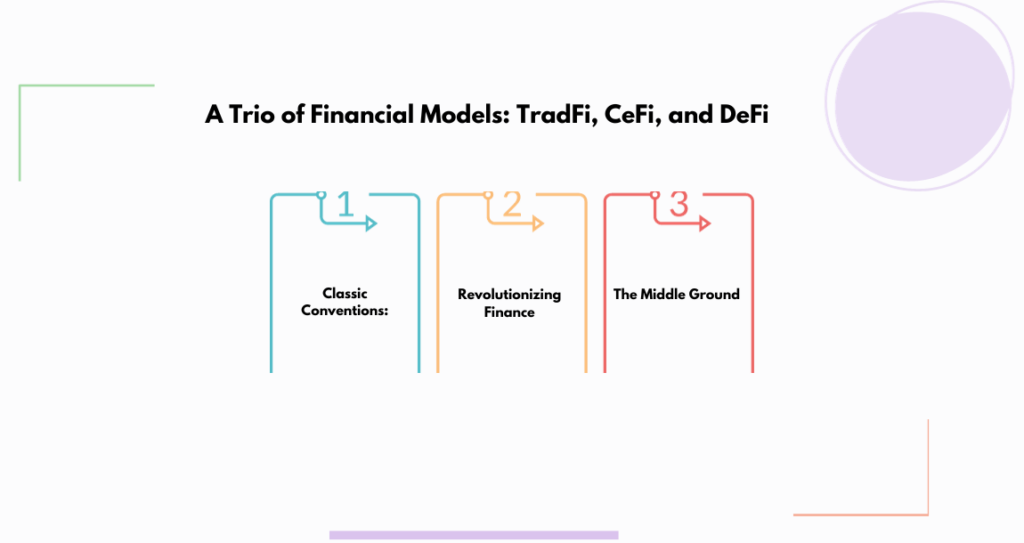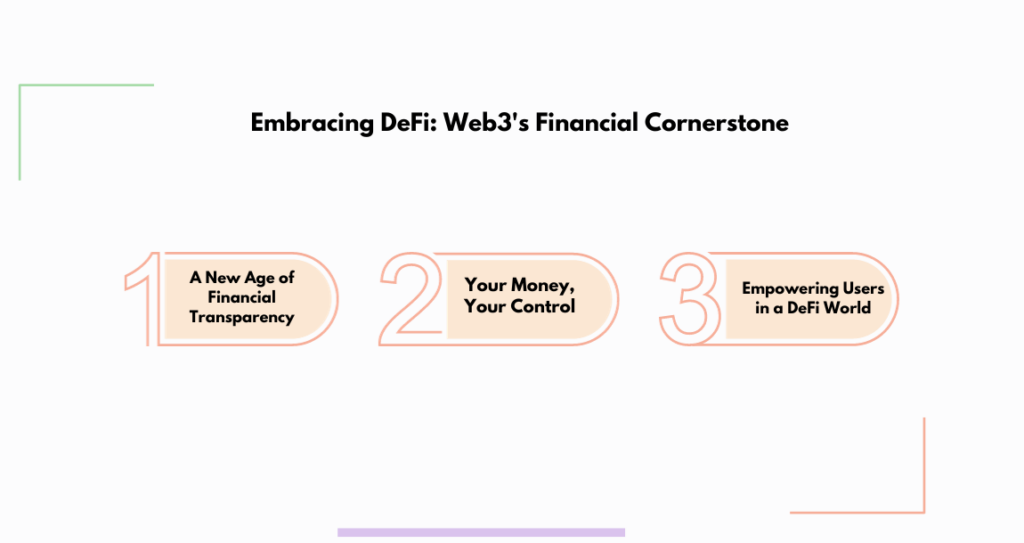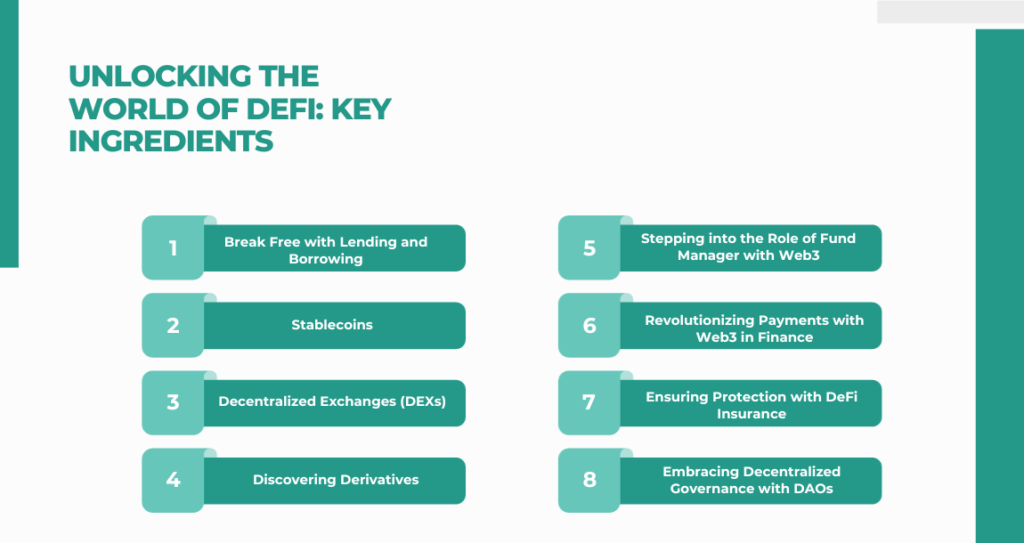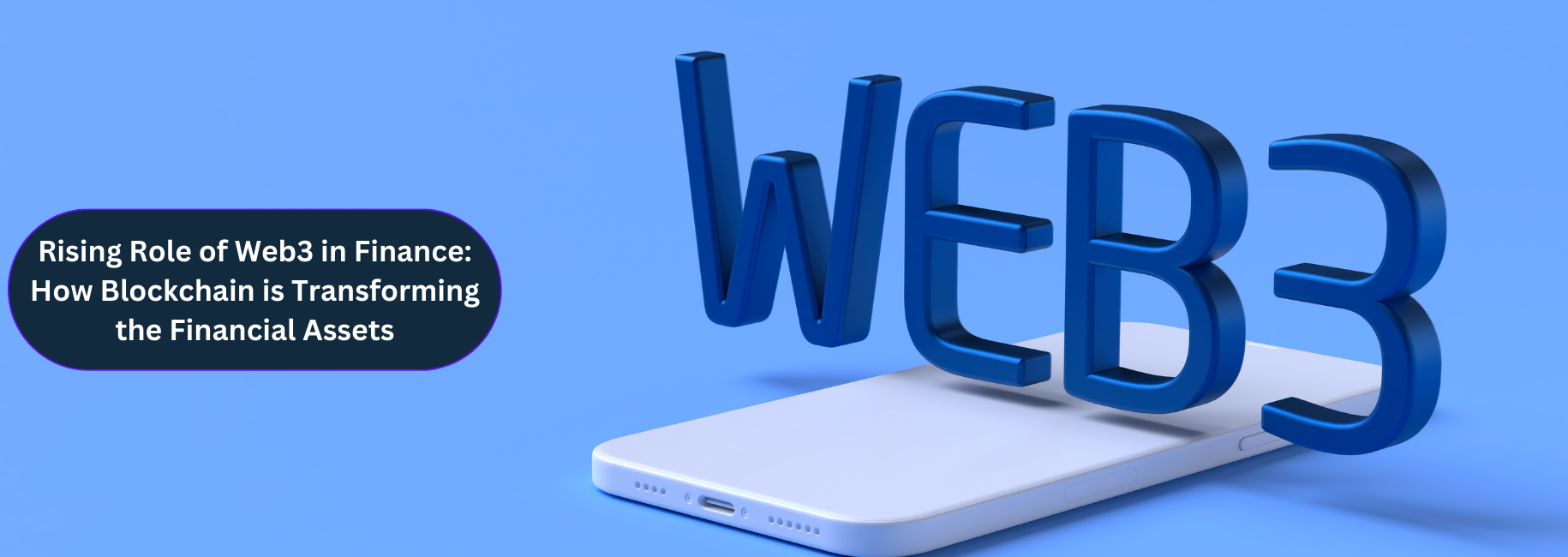Dive into the world of ‘web3 in finance’—a technological revolution that’s redefining the traditional boundaries of the financial ecosystem.
Through DeFi and web 3.0, this cutting-edge fusion is transforming financial interactions from daily transactions to detailed asset management.
It heralds a shift towards a more transparent, open, and accessible financial world, where intermediaries no longer dictate terms.
Join us as we journey through this vibrant landscape, decoding its nuances, and exploring its limitless possibilities.
Contents
- 1 What Exactly is a Financial System? What are the Flaws in the Existing Centralized Financial Framework?
- 2 A Trio of Financial Models: TradFi, CeFi, and DeFi
- 3 Embracing DeFi: Web3’s Financial Cornerstone
- 4 The Dawn of Decentralized Finance: A Response to a Crisis
- 5 Unlocking the World of DeFi: Key Ingredients
- 5.1 1. Break Free with Lending and Borrowing
- 5.2 2. Stablecoins: Bringing Stability Amid Volatility
- 5.3 3. Decentralized Exchanges (DEXs): Retaining Control Over Your Assets
- 5.4 4. Discovering Derivatives: The New Frontier in DeFi
- 5.5 5. Stepping into the Role of Fund Manager with Web3
- 5.6 6. Revolutionizing Payments with Web3 in Finance
- 5.7 7. Ensuring Protection with DeFi Insurance
- 5.8 8. Embracing Decentralized Governance with DAOs
- 6 The DeFi Advantage: Tackling the Shortcomings of Centralized Finance
- 7 Wrapping Up
What Exactly is a Financial System? What are the Flaws in the Existing Centralized Financial Framework?
Delving into the heart of the financial world, we find an intertwined web of institutions—banks, stock exchanges, and insurance corporations, to name a few.
This complex network is what we call a financial system, and it acts as a platform where money seamlessly changes hands.
Whether it’s a multinational business or a local store, at a regional or global scale, everyone dips their toes into the financial system’s waters, making or receiving payments, and investing or borrowing funds.
The intricacy lies in the guidelines that govern these financial transactions: what projects get the green light for funding, who pours money into these ventures, and what contractual terms are mutually agreed upon.
Unfortunately, these rules are predominantly crafted by the financial institutions themselves, from governments to banks.
This centralized control is often perceived as a major roadblock by customers, who often find themselves merely passengers in a journey where they should be co-pilots.
The ripple effects are far-reaching, as even the financial policies established fall short of meeting the real-life needs of the average consumer.
Centralized Finance: A System Serving Few
Centralized finance could be viewed as a behemoth that undermines the essence of financial inclusion. Instead of making financial services accessible to all, it often leaves individuals feeling like mere spectators.
So, is there a better path? The emerging world of decentralized finance (DeFi) suggests there might be. In the upcoming sections, we’ll delve into the paradigm shift of DeFi, or web3 in finance, and how it can help navigate the shortcomings of a highly concentrated financial system.
A Trio of Financial Models: TradFi, CeFi, and DeFi

Our monetary system functions within a trifold structure: traditional finance (TradFi), centralized finance (CeFi), and decentralized finance (DeFi).
While TradFi is linked to the traditional exchange of fiat currency, both CeFi and DeFi revolve around the dynamic world of cryptocurrencies.
Let’s unpack each model for a well-rounded perspective.
1. Classic Conventions: Traditional Finance (TradFi)
When it comes to financial systems, TradFi—traditional finance—forms the bedrock. It’s your classic collection of financial establishments, from retail banks to commercial banks, investment houses, and even modern fintech firms.
Think of organizations like Goldman Sachs, Morgan Stanley, or PayPal, and you have a glimpse into the world of TradFi. These institutions, often housed within physical buildings, offer a range of financial services.
While these institutions are slowly embracing the digital revolution, their operational style is still heavily centralized and entry barriers remain high.
Unlike web3 finance models, they are bound by stringent Anti-Money Laundering (AML) policies and Know Your Customer (KYC), further preserving the traditional norms of the financial sector.
2. Revolutionizing Finance: Decentralized Finance (DeFi)
Decentralized finance, better known as DeFi, has become the face of web3 in the financial sector. This groundbreaking movement leverages blockchain technology to democratize financial transactions, making them accessible and inclusive.
The rise of DeFi has been rapid and dramatic, with its market capitalization catapulting from a mere $700 million in early 2020 to an impressive $15 billion by year-end.
Here’s a look at the transformative perks DeFi brings to the table:
Inclusivity
With just a DeFi-linked wallet, anyone can unlock the gateway to its services. No need for traditional account openings or mounds of paperwork.
Privacy-First Approach
DeFi platforms put privacy at the forefront. There’s no need to reveal your identity or share personal details such as your name or email address.
Ease of Transactions
Moving assets across accounts becomes a breeze. Transfers can be conducted without seeking permission, offering users unparalleled flexibility.
Speed
Expect swift updates on interest rates and rewards, sometimes as quickly as every 15 seconds.
Transparency
In stark contrast to traditional systems, DeFi records all transactions openly, offering an unmatched level of transparency and accountability.
Ever wondered who’s powering this innovative wave of web3 applications? Meet Webisoft, your trusted partner in the realm of decentralized apps or dApps.
As a leading web3 dApps Development Company, we’re committed to helping you harness the potential of this game-changing technology.
3. The Middle Ground: Centralized Finance (CeFi)
The third player in this finance trifecta is CeFi or Centralized Finance. Nestled within the web3 finance sphere, CeFi opens the door to lucrative cryptocurrency investment opportunities.
It merges the best of both worlds, bringing together DeFi’s yield benefits with the familiar security and usability of TradFi.
CeFi operates on a financial framework where users can leverage their cryptocurrency assets to secure loans or earn interest via centralized exchanges.
Here, the custodianship of your private keys—the necessary tools for making payments and placing coin orders—lies with the chosen third-party service provider.
This system strives to promote fair exchanges while optimizing transactional efficiency and cost-effectiveness.
The expansive range of services offered by CeFi includes earning interest on securing loans, savings, and using a crypto debit card for day-to-day expenses, among others
Embracing DeFi: Web3’s Financial Cornerstone

When you journey through the intricacies of Decentralized Finance, or DeFi, you’re treading the key financial facet of the all-encompassing web3 architecture.
Essentially, DeFi encapsulates a wide array of financial offerings and tools that thrive on a web of decentralized computer networks.
A New Age of Financial Transparency
Structured in a way that bypasses traditional intermediaries, DeFi brings to the forefront a novel level of transparency that’s rapidly changing the financial landscape. There are few key traits that set apart the DeFi aspect of web3:
- Crystal clear transparency
- Freely accessible source code
- Unrestricted operational abilities
- Decentralized oversight and decision-making
Your Money, Your Control
This non-centralized way of managing finances does away with any intervention by central authorities, making it universally accessible.
Through a DeFi platform, you’re not just a user but also a participant in control of your financial journey.
This enables you to:
- Enjoy full sovereignty over your assets
- Facilitate transactions and exchanges on a peer-to-peer level
- Engage in not just using but also building Decentralized Applications (dApps)
Empowering Users in a DeFi World
The key to DeFi’s appeal lies in its disruption of traditional finance, providing a playground that eliminates the need for banks and brokerages. This equips users with unparalleled capabilities and independence, including
- Lending and borrowing of capital
- Cryptocurrency trading
- Earning interest on your nest egg
- Purchasing insurance policies
- Participating in derivatives trading
In essence, DeFi is leading the way in financial innovation, ushering in an era where users reclaim control of their financial destinies in a transparent, decentralized world.
The Dawn of Decentralized Finance: A Response to a Crisis
Prior to the turbulent year of 2008, our global financial realm operated within a wholly centralized framework.
Yet, the financial crisis that struck that year became the unexpected catalyst accelerating the growth of the DeFi, or decentralized finance, revolution.
It was true that murmurs of web3 finance concepts and attempts at constructing decentralized digital currencies had been around for a while.
Still, the 2008 financial cataclysm truly ignited the flame of the decentralized finance wave in the world of web3.
Fueled by a mounting sense of dissatisfaction with conventional financial practices, innovators put their noses to the grindstone.
A landmark moment arrived in October 2008 when an entity (or entities) known only as Satoshi Nakamoto presented their visionary Bitcoin whitepaper.
This document proposed a radical idea: a digital form of currency. The domino effect was immediate, laying the foundation for the cryptocurrency and blockchain industry, which in turn gave birth to the concept of DeFi, the poster child of web3 finance.
Cryptocurrencies: The Building Blocks, Not the Endgame
While the arrival of cryptocurrencies addressed some fundamental financial needs—safe storage and easy transfer of funds—it didn’t go far enough. These functions, as crucial as they are, represent only the tip of the financial iceberg.
For a truly autonomous, decentralized financial ecosystem to thrive, users needed more diverse functionalities with their crypto holdings.
In response to this growing demand, a bouquet of DeFi services was cultivated, designed around the specific needs and aspirations of users.
Peer to peer investments, lending, borrowing, and earning interest on crypto assets become possible, circumventing traditional central authorities.
A Leap Forward: Decentralized Applications (dApps) and Smart Contracts
The core of the DeFi model lies in the arsenal of financial tools it offers, primarily in the guise of decentralized applications, or dApps.
These tech wonders are driven by smart contracts, bestowing individuals with unprecedented control over their finances.
Such solutions effectively lower the barriers to entry into financial markets, making them more accessible than ever. Additionally, they tackle the risk associated with a single point of failure, a persistent Achilles’ heel in centralized systems.
Looking back, the financial meltdown of 2008 served as an unlikely blessing, setting the stage for a transformative leap in the financial world.
It offered a beacon of hope to a global population yearning for a more trustless, democratic approach to their financial activities.
Unlocking the World of DeFi: Key Ingredients

Unraveling the web3 financial layer takes us to Decentralized Finance or DeFi, its pulsating heart. A mosaic of elements, DeFi’s transformative power resonates through its crucial constituents.
Let’s delve into what gives DeFi its distinct essence in the web3 domain.
1. Break Free with Lending and Borrowing
Traditionally, financial services have been a privilege of those with bank accounts—a luxury still inaccessible to a significant part of the global population.
From establishing creditworthiness to offering collateral, the path to borrowing is riddled with hurdles.
The dawn of DeFi in the web3 realm simplifies this process. It eliminates the requirement of a bank account, and any checks on your credit score become redundant.
The web3 approach allows anyone to leverage their digital assets as collateral for loans. Moreover, by contributing to lending pools, you can earn returns on your assets.
DeFi democratizes lending and borrowing, making it an inclusive process for everyone.
2. Stablecoins: Bringing Stability Amid Volatility
Cryptocurrencies are notoriously volatile. Stablecoins, designed to provide stability in this fluctuating landscape, are pegged to more stable assets, such as the US dollar, providing a buffer against rapid price changes.
USDT, or Tether, emerged as one of the first stablecoins but was centralized, and users had to trust that sufficient USD reserves backed it.
Web3 ushers in decentralized stablecoins, which offer an elegant solution. Created through over-collateralization, they operate on blockchain platforms and are overseen by Decentralized Autonomous Organizations (DAOs). As such, the reserves backing these stablecoins are publicly verifiable.
3. Decentralized Exchanges (DEXs): Retaining Control Over Your Assets
Cryptocurrency exchanges are the crossroads where different cryptocurrencies meet and can be swapped. Renowned platforms like Coinbase and Binance have risen to popularity.
However, these platforms are centralized, acting not only as intermediaries but also as custodians of the assets being traded.
Such a setup contradicts the web3 ethos, where the user should maintain control over their assets. Centralized platforms pose a risk if they are compromised or face operational challenges.
Enter Decentralized Exchanges (DEXs). DEXs pave the way for users to exchange their digital assets without surrendering their custody, aligning perfectly with the web3 vision.
4. Discovering Derivatives: The New Frontier in DeFi
Derivatives, contracts whose value is tied to an underlying asset, play an important role in Web3 finance thanks to their well-established role in traditional finance.
It’s natural for any budding financial market teeming with risk and speculation opportunities to spark a need for derivatives.
Furthermore, the derivative market’s evolution often mirrors the development speed of the underlying market.
While centralized finance (CeFi) derivatives are tightly regulated and have taken years to evolve, their decentralized counterparts march to a different drumbeat.
Decentralized derivatives can be created openly, without permissions or limits, much like their traditional counterparts.
Top DeFi derivative protocols like Synthetix, UMA, Hegic, Opyn, Perpetual, dYdX, and BarnBridge are leading the pack. Even though DeFi derivatives are in their infancy, they are growing at a pace akin to other crypto assets.
5. Stepping into the Role of Fund Manager with Web3
The advent of web3 in finance has ushered in an era where the everyday person can don the hat of a fund manager, empowering them to make investment choices that align with their needs.
This involves managing their assets effectively, including taking care of cash flow, to ensure a return on investment.
When it comes to DeFi fund management, two primary styles emerge: active and passive fund management.
Active management involves a team making investment decisions with the objective to outperform a specific market benchmark, like the Standard & Poor’s 500 Index.
Passive management, on the other hand, mirrors the holdings of a particular index to achieve similar returns.
Web3’s defining feature, transparency, allows users to easily see how their funds are being managed, giving them a clear view of their financial journey.
6. Revolutionizing Payments with Web3 in Finance
One can’t overlook the transformative role cryptocurrencies play in enabling trustless, decentralized value transfers between parties. As web3 reshapes the financial landscape, cutting-edge payment methods are coming to the fore.
Notably, most peer to peer transactions are facilitated by decentralized apps (dApps), known for their robust security, accessibility, and simplicity.
Web3 finance offers a permissionless and fully encrypted infrastructure, which enables transactions to be processed nearly instantly. This cuts out the need for end users to pay additional processing fees to intermediaries.
Opting for DeFi payments significantly reduces risks, costs, hassle, and even cash processing times.
Moreover, DeFi empowers businesses to make secure, scalable, and automated payments, often integrating smoothly with their existing ERP systems. This translates to streamlined workflows and a shorter learning curve.
7. Ensuring Protection with DeFi Insurance
DeFi is reimagining insurance – an arrangement where a company promises to cover losses, damages, or even death. DeFi insurance covers multiple risks, including smart contract breaches, protocol attacks, and multi-sig wallet problems.
Unlike traditional markets where policyholders must prove their loss for a valid claim, DeFi introduces the concept of parametric insurance.
In this model, payouts are initiated once the stipulated policy parameters are met. Using DeFi’s smart contracts, which self-execute based on predefined conditions, claim filing is eliminated.
This not only makes the process quicker and more efficient but also rules out the possibility of fraudulent claims. Hence, web3 finance overhauls the insurance sector, policyholders, and benefiting both insurers.
8. Embracing Decentralized Governance with DAOs
The discussion of web3 in finance wouldn’t be complete without a nod to Decentralized Autonomous Organizations (DAOs).
As decentralized entities, DAOs spread power across an organization, ensuring members’ interests align and no one can exploit others.
DAOs are pivotal to community-driven initiatives, including DeFi projects.In a way akin to traditional business management, DeFi governance is leveraged by DeFi protocols for project administration.
Governance tokens give users voting rights and influence over the protocol’s roadmap. Numerous toolkits and decentralized apps have been developed to reinforce effective governance and augment existing systems.
The DeFi Advantage: Tackling the Shortcomings of Centralized Finance
For eons, we’ve operated in a world where money is governed by a centralized authority—where central banks control currency circulation, intermediaries manage financial exchanges, and traditional banking systems dominate lending and borrowing.
But with the dawn of web3 in the finance world, a fresh paradigm, decentralized finance or DeFi, has emerged.
This model encourages peer-to-peer transactions via a distributed ledger, with no central organization pulling the strings.
But what are the problems that DeFi aims to solve? Let’s delve in.
The Stranglehold of Centralized Control
Web3 in finance is a game-changer—it eradicates the necessity for a centralized financial structure, extending the reach of financial services, irrespective of geographical barriers or personal identity.
Primarily accessible via decentralized applications (dApps), DeFi offers users enhanced command over their finances.
Users have their personal crypto wallets and enjoy an array of trading and other services designed around their needs.
Bridging the Access Gap
In our world, billions of people are stranded without access to a bank account. This massive barrier hinders their ability to participate in financial activities. With no secure way to engage in financial transactions, even large-scale trading becomes a distant dream.
This gaping hole in financial access is a major reason why individuals resort to expensive payday loans to alleviate liquidity shortfalls.
And being ‘banked’ isn’t the ultimate solution either—it doesn’t guarantee immediate access to funds, especially for small, fledgling companies.
Here, web3 in finance steps in. DeFi opens its doors to everyone, removing any meddling middlemen from users’ financial affairs.
Efficiency Woes
Centralized financial systems are riddled with flaws. Staggeringly high credit card interchange rates, exorbitant remittance fees, and lengthy payment settlement times form a part of the problem.
Further complicating matters are microtransactions, security vulnerabilities, steep brokerage fees, and delayed fund transfers.
In addition to these, banks, burdened with the costs of maintaining physical premises, often set high loan rates and low deposit interest rates.
Enter web3 finance—DeFi acts as a balm to these glaring inefficiencies in the centralized financial system.
Thus, it paves the way for web3 finance to become a favored choice for many.
The ‘Island’ Syndrome of Traditional Finance
Our current financial system is reminiscent of isolated islands, with significant barriers to interaction and cooperation.
Add to this the high costs associated with switching financial providers and the convoluted process of transferring funds between institutions.
A simple wire transfer, for instance, can take up to three days to settle. Enter web3 in finance—it has the power to eliminate these barriers and foster cooperation within the DeFi ecosystem, making the transfer of funds more streamlined and cost-effective.
The Fog of Finance
Centralized finance is notorious for its opacity. Often, customers are left in the dark with insufficient information to make educated financial decisions. It’s challenging for customers to ascertain if the loan rates offered to them are competitive.
Some progress has been made in fintech services related to insurance, helping consumers find the “lowest” rate. However, the loan market remains a fragmented landscape.
Plus, these “lowest” rates still reflect the high costs of maintaining physical bank branches and back-office expenses. This lack of clarity negatively impacts everyone involved—from lenders to borrowers.
Bye-Bye, Intermediators
One of the crown jewels of web3 in finance is its ability to bypass middlemen. DeFi revolutionizes the financial system by leveraging smart contracts, which not only secure the custody of funds but also manage their distribution.
By removing human intermediaries, DeFi slashes the potential for errors, delays, and biased decisions.
Avoiding the Domino Effect
DeFi projects counteract risk by eliminating the dreaded ‘single points of failure.’ Their operations are dispersed, with all financial records stored on the blockchain.
And, since blockchains are distributed ledgers, even if one node falls, the network continues to operate smoothly.
Governance of DeFi protocols is also decentralized, thanks to Decentralized Autonomous Organizations (DAOs), further boosting the efficiency of DeFi operations.
Countering Corruption
With intermediaries shown the door and financial records spread across a distributed ledger, DeFi considerably reduces the risk of corruption.
The unalterable nature of distributed ledgers offers a security level that far exceeds traditional centralized financial record systems.
No profit-seeking bankers or brokers can exploit the system to their advantage. Additionally, decentralized governance allows users to call the shots, deciding what’s best for them and their communities.
This shields the organization from any individuals or groups aiming to manipulate decisions for personal gain.
Wrapping Up
In the whirlwind tour of ‘web3 in finance’, we’ve discovered its profound impact on the world’s financial systems, shedding light on how it empowers users, fosters transparency, and reduces dependencies on intermediaries.
It’s clear that web3 is not merely a technological novelty; it’s a transformational force that’s reshaping finance as we know it, giving rise to a more equitable and democratic financial order.
As we navigate through this evolving landscape, one thing remains certain: the web3 revolution in finance is just beginning.
Ready to seize the opportunities presented by web3 in finance? Partner with Webisoft today and navigate the exciting world of decentralized finance with confidence.
As seasoned experts, we harness cutting-edge technology to build web3 solutions that cater to your specific needs.

